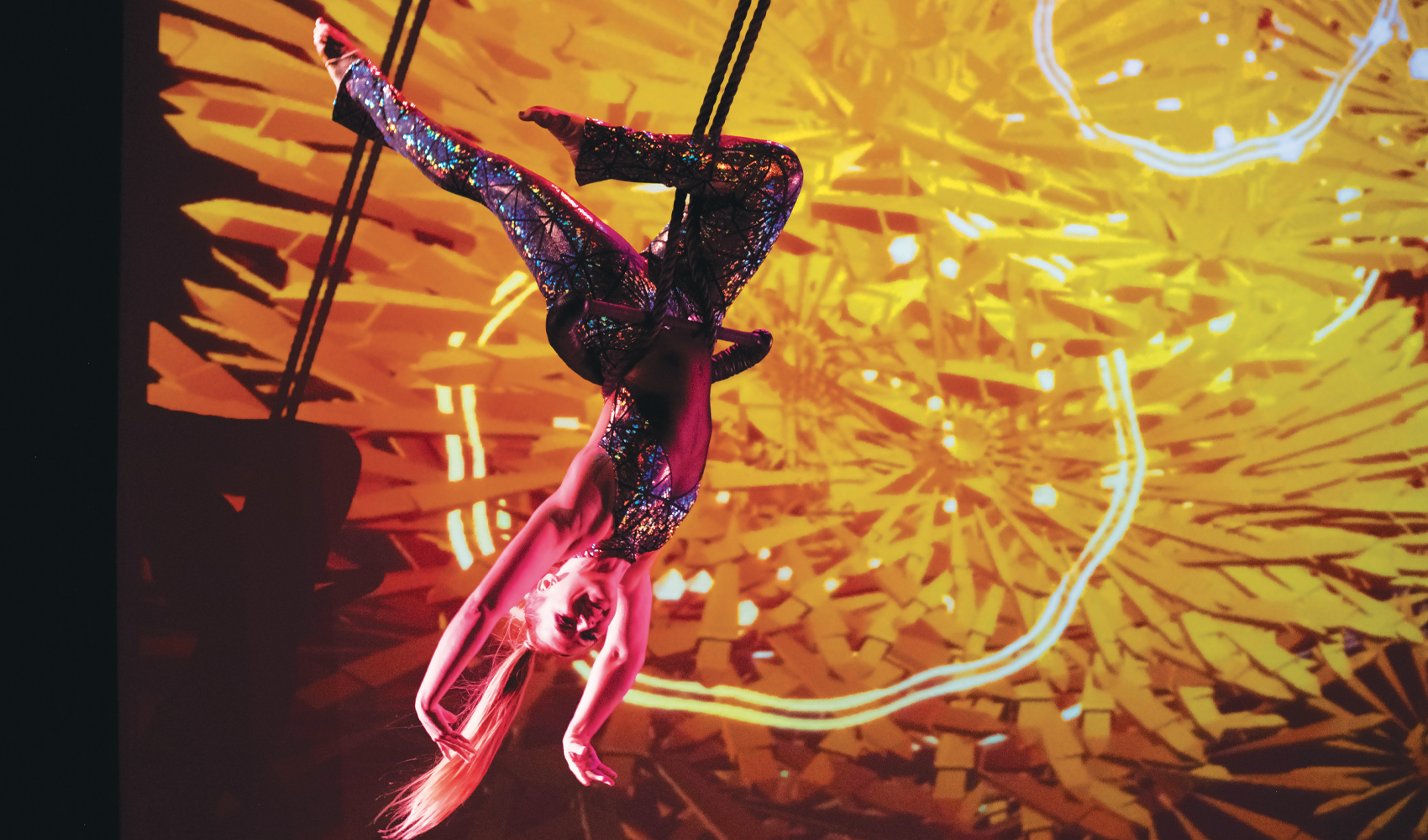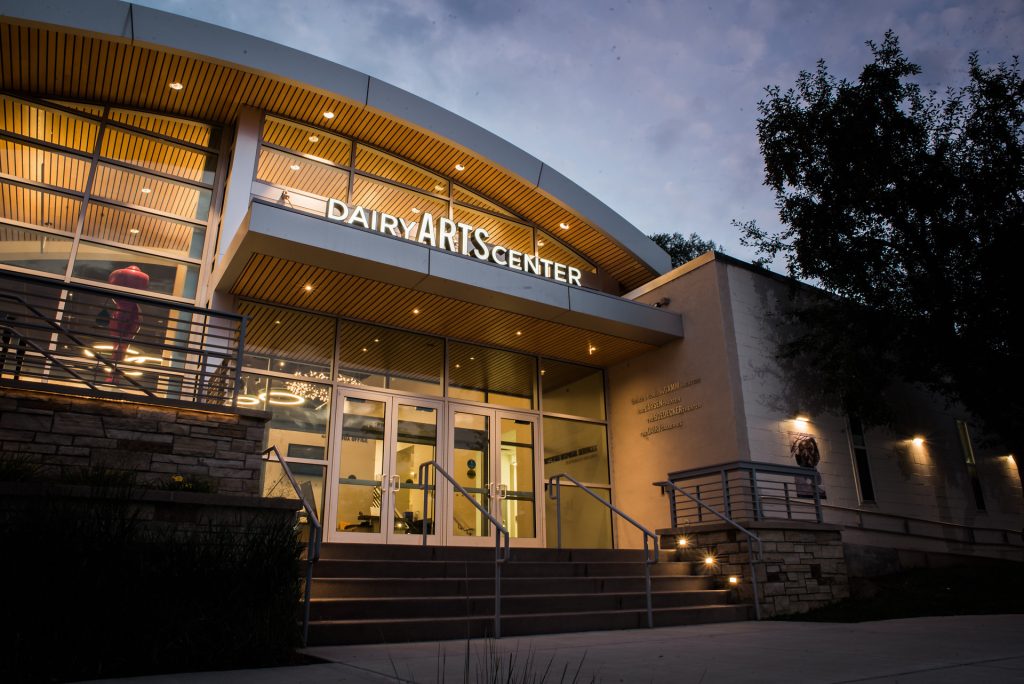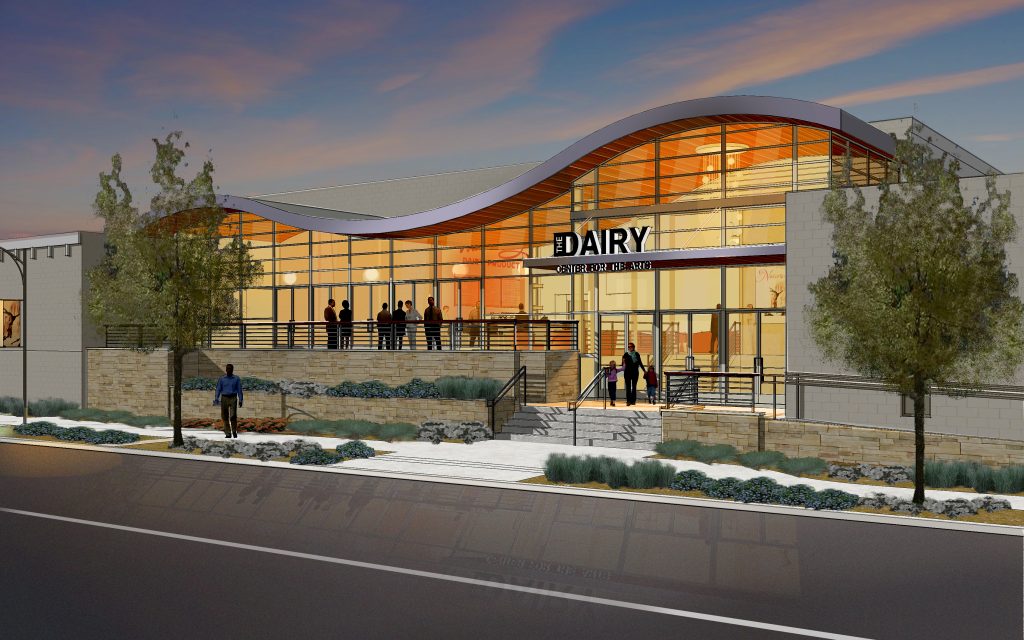
No cows ever roamed the building, but the Dairy Arts Center was once indeed a real dairy. Long before it was the multidisciplinary arts hub Boulder residents know today, the facility then-operated by the Watts-Hardy Dairy Company processed, bottled and home-delivered milk to customers throughout the city.

Originally located at 1245 Walnut St. in 1882, the company relocated to a new plant at 26th and Walnut in 1970. By 1983, Sinton Dairy’s acquisition and subsequent closure of operations rendered the site dormant. Four years later, video artist Russ Wiltse — a member of the community arts group VisualEyes, tasked with finding a venue for an upcoming show — thought the building had potential. So he got permission from Sinton to host an event in the space.
“My dream was an artists’ community,” Wiltse said in an archived oral history interview with Sue Deans. “The idea was if we squatted there long enough, we could build support.”
His audacious gamble paid off. The Dairy has since expanded its role in Boulder’s cultural landscape, becoming the city’s largest multidisciplinary arts venue. With its wide range of visual arts, theater, film, dance and live music offerings, the center serves as a beacon for artists and audiences of all types.
“All the arts organizations are in one place,” says Mark Ragan, the managing director of Boulder Ensemble Theater Company (BETC), a long-time renter of the venue. “During intermission, you’re probably going to rub shoulders with folks from the Boulder Ballet, at The Catamounts show or maybe coming out of an indie film at the Boedecker Theater. I always thought of the Dairy Arts Center as the Grand Central Station of performing arts in Boulder.”
From vacant space to creative haven
Beginning in 1988, Sinton allowed VisualEyes to perform at the facility. The company also opened its office space to an alliance of arts organizations called Flatirons Center for the Arts (FCA) and sublet space to the Colorado Dance Festival and Boulder International Chamber Players, who became the building’s first tenants. Sinton just charged for utilities; there was no rent.
The facility wasn’t glamorous, but the artists began to devise a plan to acquire it. To secure the capital necessary to purchase the building, the FCA agreed to demolish a 4,000-square-foot section so Sinton could sell it to an interested housing developer for around $1.4 million.

The FCA eventually worked out a deal with the City of Boulder and Sinton to obtain a 90-day option to purchase the building. To remain there permanently, they needed to raise the funds to buy the property at the sale price of $750,000. They held several fundraisers over the next few years while forming a board to obtain its 501(c)3 nonprofit status in 1992 and, with the help of the City, bought the building the following year.
From its inception, the FCA — which changed its name to the Dairy Center for the Arts in 1994 — was envisioned as a place for both classes and performances. Under the guidance of its first official director, Margi Ness, the arts center underwent its first major renovation in 1998.
“The cost of renovating far exceeded what had been expected,” says Deborah Malden, a former board member and interim executive director in 2008 who currently serves as arts liaison and advisor at the Boulder Chamber. “That first renovation was a tough period. There were cost overruns, and the City took the assets back in lieu of the mortgage. The City became the owner of the Dairy, which had not been their expectation in the initial years when they helped jumpstart the effort. It was a grass-roots, artist-led initiative for the arts community.”
This arrangement allowed the City to lease the space to the nonprofit operating the building. In subsequent years, the organization added the Boedecker Theater and new gallery spaces, tightened its name in 2015 to the Dairy Arts Center and spent $4.3 million on lobby and theater renovations, which helped cement its position as Boulder’s cultural epicenter.
“We’re stewards of this building,” says current executive director Melissa Fathman. “The Dairy has three live performance spaces, and there are times when every single theater has something going on: Films are playing, stuff is happening in the galleries and we even have things in the lobby. Several years ago, there weren’t as many groups or artists, so it was fairly easy to accommodate everyone. Then, especially after we did the renovation, more people were like, ‘I want to perform here.’ So we had to figure out a fair way to do this.”

Credit: Zach Weinstein
A logistical ballet
The Dairy’s role as Boulder’s primary arts venue comes with its challenges. The reservation process, crucial for the survival and flourishing of local nomadic troupes, is a complex puzzle. Its calendar is meticulously planned and often booked solid months in advance, underscoring the fierce competition for space among the city’s few performance venues.
The center’s practical scheduling and operational challenges are a delicate dance of tightly packed performance, exhibition and educational programs. This logistical ballet is meticulously managed, necessitating an equitable system to meet the diverse needs of local businesses, visiting artists and community events.
“We work with about 150 organizations and artists, but some of them rent one event and some of them have up to 16 weeks, so it’s kind of hard to count the exact number of events,” Fathman says. “During COVID, I instituted a maximum of 16 weeks per organization. It’s like a Tetris game, trying to fit everything on the calendar. You really understand how complicated the Dairy is operationally when you look at the calendar. When we’re talking with clients who are frustrated they’re not getting the dates they want, I’ve started bringing them in here so they can visualize what we are working with.”
Vonda Neely, the Dairy’s events and human resources manager, said she had already received five event applications for the week by midday on a Wednesday in early February when Boulder Weekly toured the facility. Fathman estimates they turn down approximately three events per week because they don’t have the space.
“If we can’t fit them in, and we do really try, then we suggest other places where they can go,” Neely says. “There are only a few around town, and it depends on the art form, but I typically recommend the JCC, eTown Hall or Junkyard Social Club.”
The transition to a more democratic scheduling process, aimed at fairness and inclusivity, has introduced new layers of complexity. The sheer volume of requests for space leads to difficult decisions and the inevitable turning away of some applicants.
The Dairy’s operational constraints impact not only the scheduling of events but also limit the potential for larger productions and longer runs that could serve a wider audience. For instance, BETC used to perform for over 20 weeks at the venue but is now capped at 16 weeks.
“We just dealt with it,” Ragan says. “One of the reasons we go to Denver and do parallel programming at The Savoy is because we don’t feel like we have enough time at the Dairy.”
Ragan attributes these issues to a lack of infrastructure in a city that “desperately needs an enormous performing arts center.” Calling on local officials to help make that dream a reality, he says the load can’t be carried by Fathman and her staff alone.
“Our challenges are kind of endemic to the problems anyone producing shows in Boulder is going to face,” he says. “Whether it’s The Catamount, Local Theater Company, us or any other performing group, there’s one game in town, and it’s called the Dairy Arts Center.”

‘It could be so much more’
As the Dairy navigates these challenges amid an ever-shifting live entertainment industry, the conversation around real estate scarcity and the future of performing arts in Boulder takes on a new tone of urgency. If you ask Fathman, there’s one major solution that could help alleviate the pressure: a new, bigger performing arts venue.
“Before BDT Stage closed or even COVID hit, Boulder had a space problem,” Fathman says. “Our largest theater has 250 seats, which is not really that big. If you want to do a larger production or a more expensive one, it’s almost impossible because you can only charge so much per seat. That’s a huge endeavor for sure, but I do think Boulder is ready for something that has a larger capacity. Boulder is a thriving, amazing, creative arts hub — we need to build infrastructure so the artists don’t go away.”
Looking ahead, the Dairy is not standing still. Acknowledging the current limitations and the community’s need for more cultural events, the center is actively expanding its reach beyond its physical walls. Pop-up events cheekily referred to as “Free Range Dairy” have so far been largely virtual, but Fathman hopes to expand the initiative to empty office buildings and other unconventional spaces throughout the city.
Meanwhile, investments are being made to upgrade and enhance the center’s existing facilities and offerings. One of Fathman’s proudest achievements of late is the Creative Nations Collective, a permanent facility for Indigenous artists that opened in 2022.
Malden hopes the Dairy’s journey from a derelict processing plant to a beloved arts center serves as both an inspiration and a call to action. While acting as the most crucial lifeline to the local performing arts community has pushed the ambitious facility to its limit, she sees a future where the space continues to serve its essential function without carrying the load on its own.
“If you look back at the early years, there was a belief that the Dairy could become the home for all performing artists and the classes,” Malden says. “Today, the Dairy is foundational to Boulder’s arts and culture ecosystem. It has come a very long way since its inception because of the vision and commitment of so many people in this community — and it could be so much more.”
